Unveiling Siguniang Mountain: A Hidden Gem in China’s Scenic Landscape
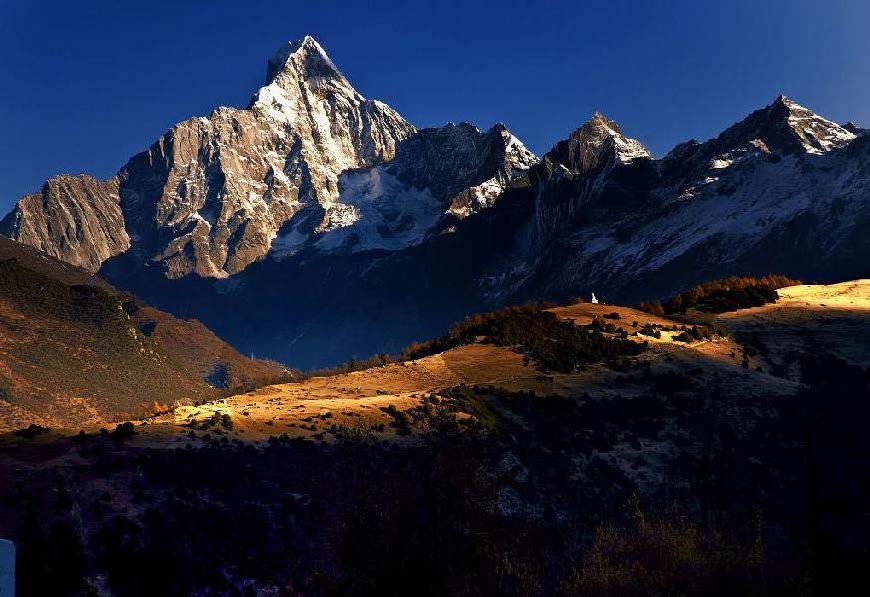
An Essential Guide to Visiting Siguniang Mountain
Nestled within the breathtaking landscapes of Sichuan Province, Siguniang Mountain, known as the Four Sisters Mountain, stands as a majestic testament to nature’s artistry. Often referred to as the “Eastward Alps,” this stunning four-peak range captivates travelers with its soaring heights and dramatic vistas. Each peak—Yaomeifeng, Sanfeng, Erfeng, and Dafeng—offers its own unique allure, beckoning adventurers and nature enthusiasts from around the globe.
As a UNESCO World Heritage site and a cherished habitat for the giant panda, Siguniang Mountain is more than just a trekker’s dream; it is a sanctuary for diverse wildlife and a haven for photographers seeking to capture the ethereal beauty of snow-capped summits, lush alpine meadows, and crystalline lakes. The region’s varied terrain presents a playground for outdoor activities, ranging from leisurely hikes to challenging climbs, ensuring that every visitor finds their own slice of paradise.
With its convenient proximity to Chengdu—just a four-hour drive—Siguniang Mountain is accessible yet feels worlds away from the bustle of city life. Whether you’re seeking the thrill of conquering towering peaks or simply yearning for a tranquil escape among nature’s wonders, this stunning mountain range promises an unforgettable experience. So lace up your hiking boots, breathe in the crisp mountain air, and prepare to embark on an adventure that will leave you in awe of the raw beauty that is Siguniang Mountain.
In This Guide
- An Essential Guide to Visiting Siguniang Mountain
- The Rich History and Legends of Siguniang Mountain
- Main Highlights: What You Absolutely Can’t Miss
- Planning Your Visit: A Practical Guide
- Tickets: Prices, Booking, and Tips
- How to Get There: A Complete Transportation Guide
- Local Cuisine and Accommodation Nearby
- Frequently Asked Questions
- Final Thoughts on Your Trip
The Rich History and Legends of Siguniang Mountain
Nestled in the heart of Sichuan province, Siguniang Mountain, also known as the Four Sisters Mountain, is not only a breathtaking natural wonder but also a site steeped in rich history and local legends. The mountain is named after four peaks—Yaomeifeng, Sanfeng, Erfeng, and Dafeng—each representing one of the four sisters in an ancient Tibetan tale, embodying themes of beauty, strength, and resilience.
According to local folklore, the four sisters descended from the heavens and took on human form, living in harmony with the natural world. This legend resonates deeply with the local Tibetan and Qiang communities, who regard the mountains as sacred guardians. The peaks are believed to hold the spirits of the sisters, watching over their descendants and blessing the land with fertile pastures and abundant wildlife.
The history of human interaction with Siguniang Mountain stretches back centuries. The area has long been inhabited by the Qiang people, who have cultivated a rich cultural heritage intertwined with the mountains. The Qiang are known for their intricate wooden architecture, vibrant festivals, and unique craftsmanship, all of which reflect their deep connection to the land. Traditional practices, such as herding yaks and engaging in agriculture, have shaped the landscape around the mountain, creating a picturesque setting that attracts travelers from across the globe.
In the modern era, Mount Siguniang gained prominence as a trekking destination in the late 20th century, drawing adventurers and nature enthusiasts eager to explore its stunning landscapes. The establishment of the Siguniang Mountain Scenic Area in 1989 marked a significant turning point, leading to increased efforts to preserve its natural beauty and promote sustainable tourism. This development also helped protect the rich biodiversity of the region, including its famed giant pandas, which are often spotted in the lower slopes of the mountain.
Beyond its historical and cultural significance, Siguniang Mountain is celebrated for its striking geological features. Resembling the Alps with its snow-capped peaks and dramatic valleys, it has been referred to as the “Eastern Alps.” The unique topography is a result of millions of years of geological activity, creating an environment that is both awe-inspiring and challenging for climbers and trekkers.
As you explore the trails of Siguniang Mountain, you’ll encounter not only breathtaking vistas but also the echoes of its rich history, woven into the very fabric of the landscape. The blend of legend, culture, and natural beauty makes this mountain a truly enchanting destination, inviting travelers to immerse themselves in its story while embarking on their own adventures. Whether you’re drawn by the allure of ancient tales or the call of the wild, Siguniang Mountain promises an unforgettable journey into the heart of China’s mountainous heritage.
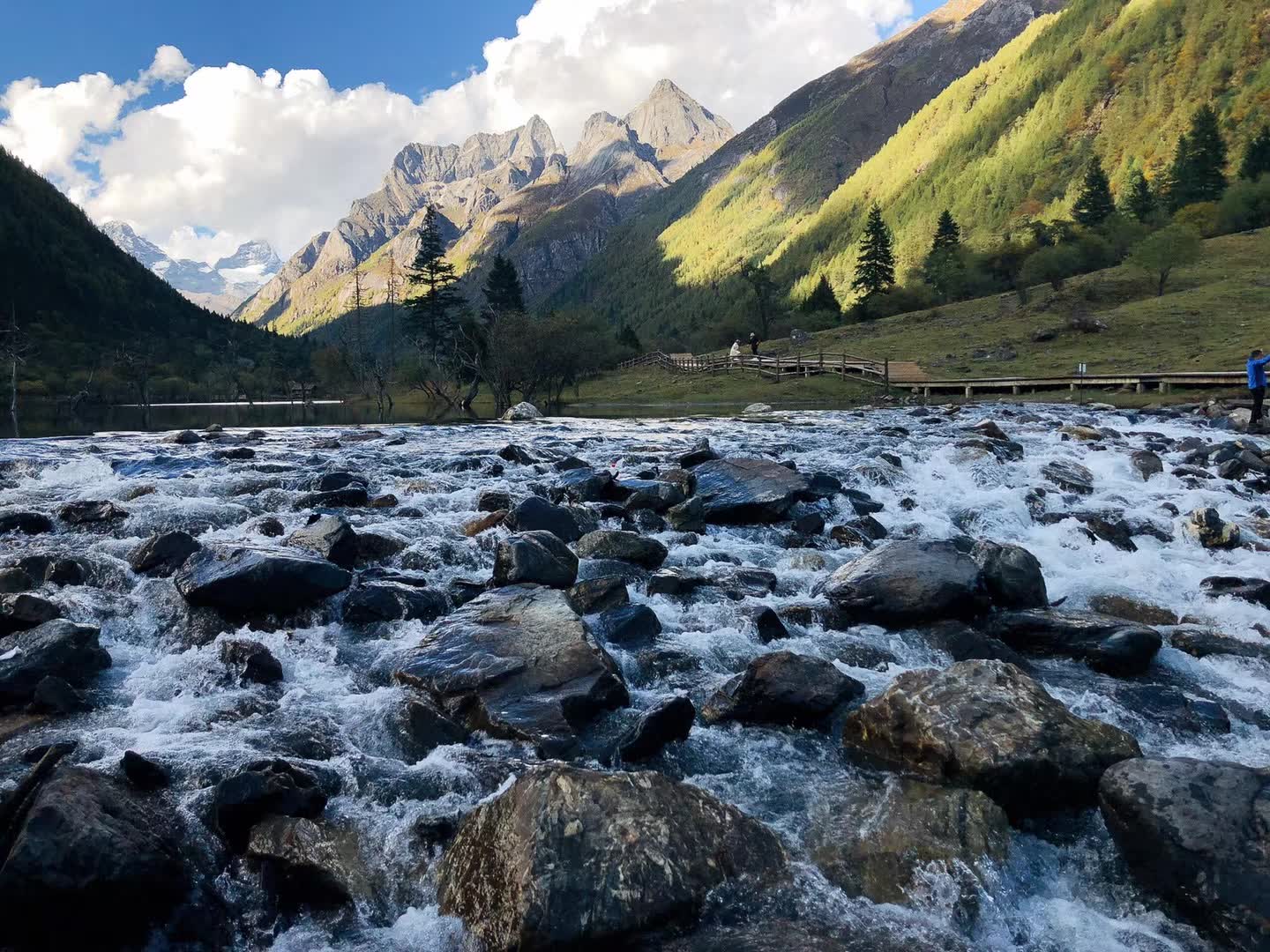
Siguniang Mountain.
Main Highlights: What You Absolutely Can’t Miss
Nestled in the breathtaking landscapes of Sichuan Province, Siguniang Mountain, often referred to as the Four Sisters Mountain, is a treasure trove of natural beauty and adventure. With its towering snow-capped peaks and rich Tibetan culture, this region offers experiences that will leave you in awe. Here are the main highlights that you absolutely can’t miss during your visit to this stunning destination.
The Majestic Four Peaks
Yaomeifeng (6,250m)
The highest and most revered of the four peaks, Yaomeifeng stands tall as the “Queen of Mountains in Sichuan.” Its slender silhouette and challenging ascent attract mountaineers from around the globe. Whether you are an experienced climber or simply wish to admire its beauty from below, a visit to Yaomeifeng is essential.
Sanfeng (5,664m)
Known for its unique topography and diverse flora and fauna, Sanfeng presents an enchanting sight year-round. Home to many rare species, including the giant panda, this peak is a testament to the region’s rich biodiversity. Experience the exhilarating feeling of standing at its base, surrounded by the lush landscapes that characterize the area.
Erfeng (5,454m)
Erfeng, with its dramatic cliffs and abundant greenery in the summer, is perfect for those who seek both natural beauty and adventure. The mountain is known for its steep ascent and offers a chance to see unique wildlife and medicinal plants native to the Tibetan plateau.
Dafeng (5,055m)
Dafeng, or Daguniang Mountain, boasts a stunning array of alpine meadows and vibrant wildflowers. The contrast between the colorful flora and the snow-capped summit creates a picturesque scene that is perfect for photography enthusiasts.
Scenic Valleys
Shuangqiao Valley
The most accessible valley, Shuangqiao offers a well-paved road and eco-sightseeing buses that take you deep into its scenic heart. Here, you can stroll along wooden plank roads that meander through lush pastures, dense forests, and shimmering lakes, all framed by over ten snow-capped peaks. This valley is ideal for leisurely exploration and family-friendly hikes.
Changping Valley
Famed for its breathtaking landscapes and local Tibetan culture, Changping Valley is a haven for outdoor enthusiasts. The valley is home to the highest peak, Yaomeifeng, and offers a glimpse into traditional Tibetan life. Explore ancient battlefields and picturesque meadows, or embark on rock climbing and ice climbing adventures that challenge your skills.
Haizi Valley
The highest of the three valleys, Haizi is known for its stunning alpine lakes and expansive meadows. Its environment provides a dramatic backdrop for photographers and nature lovers alike. The valley serves as a base camp for climbers looking to tackle the Four Sisters, making it a hub of adventure.
Cultural Immersion
While the natural beauty of Siguniang Mountain is undeniable, don’t miss the opportunity to immerse yourself in the local Tibetan and Qiang cultures. Visit traditional villages, taste authentic Tibetan cuisine, and participate in local festivals, which often feature vibrant music and dance. The warmth and hospitality of the local communities offer a rich cultural experience that complements the stunning landscapes.
Outdoor Activities
With its diverse range of terrains, Mount Siguniang is an outdoor paradise. From leisurely day hikes in Shuangqiao Valley to challenging multi-day treks that summit the peaks, there’s something for everyone. Horseback riding, rock climbing, and even ice climbing in the winter months allow visitors to engage with the landscape in various exhilarating ways. No matter your skill level, the region provides endless opportunities for adventure.
Best Time to Visit
To truly appreciate the scenery and enjoy outdoor activities, plan your visit during autumn (late September to November) when the weather is mild, and the landscapes burst into vibrant colors. Alternatively, late spring and summer (May to August) are also great for trekking, with lush greenery and blooming wildflowers, but be prepared for occasional rains.
Exploring Siguniang Mountain is an unforgettable experience filled with stunning vistas, exciting adventures, and rich cultural encounters. Whether you seek serenity in nature or adrenaline in the great outdoors, this breathtaking destination has it all.

Siguniang Mountain.
Planning Your Visit: A Practical Guide
Planning Your Visit: A Practical Guide to Siguniang Mountain
Nestled in the breathtaking landscape of Sichuan, Mount Siguniang (四姑娘山), also known as the Four Sisters Mountain, beckons adventurers and nature lovers alike with its stunning peaks and rich cultural heritage. This guide will help you navigate your visit to this outdoor paradise, ensuring you make the most of your experience.
Getting There
Mount Siguniang is situated approximately 220 kilometers west of Chengdu, making it accessible via a 4-hour drive. Since there are no direct trains or flights to the mountain, your journey will begin in Chengdu. Here are your options:
- By Public Transport: Take a train or flight to Chengdu. From there, you can catch a public tourist bus to Siguniangshan Town or Rilong Town, which are the closest hubs to the mountain.
- By Private Car: For those preferring convenience, hiring a driver or renting a car is an excellent choice. This option allows for a scenic detour to attractions like the Dujiangyan Irrigation System or the Wolong Panda Base.
Best Time to Visit
To experience Mount Siguniang at its finest, timing your visit is crucial:
- Autumn (Late September to November): This is widely regarded as the best time to visit. Expect vibrant foliage, clear skies, and minimal rainfall—a photographer’s dream!
- Late Spring to Summer (May to August): This period brings warm weather and lush landscapes, although be prepared for occasional rain.
- Winter and Early Spring (December to March): Heavy snowfall during these months often makes higher trails inaccessible, so it’s best to avoid trekking in the upper elevations.
Weather Insights
Mount Siguniang enjoys a plateau climate, characterized by fresh air and significant temperature variations between day and night:
- Winter: Average temperatures hover around -2°C, with little precipitation.
- Spring: Expect mild weather with average temperatures around 7°C.
- Summer: Temperatures rise to about 12°C, but this is also the wettest season, so come prepared for rain.
- Autumn: With average temperatures around 6°C, conditions are comfortable and more stable.
Trekking Routes
Mount Siguniang features an array of trekking options catering to various skill levels. Here are some popular trails:
-
Shuangqiao Valley Day Trek: This easy trek allows you to explore scenic pastures and peaks. Take a bus to Niu Pengzi for a day of hiking.
-
Changping Valley Trek: A medium-difficulty trek that offers a mix of cultural experiences and natural beauty, including views of Yaomeifeng and local Tibetan villages.
-
Haizi Valley/Dafeng Climb: For those seeking a semi-professional challenge, this route takes you to the base camp of Dafeng with stunning alpine meadows and lakes.
-
Multi-day Expeditions: Engage in longer treks like the Changping Valley to Bipeng Valley trek, which combines scenic beauty with cultural immersion over several days.
Accommodation Options
While there are no luxury hotels in the immediate area, options range from guesthouses in Siguniangshan Town to camping sites throughout the valleys. If you’re planning a multi-day trek, be prepared to camp, as this will provide the most immersive experience in nature.
Essential Tips
- Altitude Awareness: With peaks reaching over 6,000 meters, it’s vital to acclimatize properly to avoid altitude sickness. Take it slow and listen to your body.
- Gear Up: Invest in good trekking gear, waterproof clothing, and sturdy hiking boots. Weather can change rapidly in the mountains.
- Stay Hydrated: The high altitude can be dehydrating, so drink plenty of water.
- Respect Local Culture: Siguniang Mountain is home to Tibetan and Qiang communities. Be mindful of local customs and practices.
Final Thoughts
A visit to Mount Siguniang is not just a trek; it’s an adventure that promises stunning landscapes, cultural encounters, and exhilarating experiences. Whether you’re a seasoned mountaineer or a casual hiker, the Four Sisters Mountain has something special to offer everyone. Prepare well, embrace the journey, and enjoy the enchanting beauty of this remarkable destination!
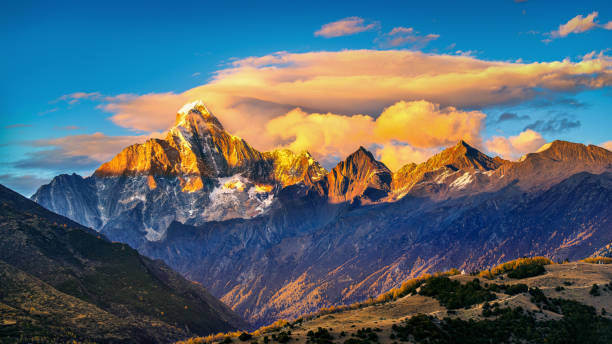
Siguniang Mountain.
Tickets: Prices, Booking, and Tips
When planning your adventure to Mount Siguniang, it’s essential to understand the ticketing process and associated costs to ensure a smooth experience. Here’s everything you need to know about ticket prices, booking options, and handy tips for your visit.
Ticket Prices
-
Entry Fee: The entrance ticket for Mount Siguniang is typically around 70 CNY (approximately $10 USD) per person. This fee grants you access to the scenic areas, including the three main valleys: Shuangqiao, Changping, and Haizi.
-
Eco-Sightseeing Bus: To explore the valleys, especially Shuangqiao Valley, you will need to use the eco-sightseeing bus service. The fare for the bus is about 20 CNY (around $3 USD) for a round trip.
-
Camping Fees: If you plan to camp in designated areas, be prepared for additional fees, which can range from 20 to 50 CNY (approximately $3 to $7 USD) per night, depending on the location and amenities.
-
Guided Tours: For those who prefer a guided experience, various tour operators offer packages that may include transportation, accommodation, and meals. Depending on the level of service, these packages can range from 500 to 2,000 CNY (about $70 to $280 USD) per person.
Booking Options
-
Online Reservations: While advance booking for entry tickets is generally not required, it’s advisable to check if any guided tours or special activities need to be booked ahead. Websites like Trip.com or local tour operators can assist in securing these arrangements.
-
On-Site Purchase: Tickets can be purchased at the entrance to Mount Siguniang. However, it’s best to arrive early during peak seasons (May-August and September-November) to avoid long queues.
-
Transportation to the Mountain: Since there are no direct trains or flights to Mount Siguniang, plan your route to Chengdu first. From Chengdu, you can take a bus or hire a private car. Buses to Siguniangshan Town leave from Chengdu’s Xinnanmen Bus Station and typically cost around 100 CNY (approximately $14 USD).
Tips for Visitors
-
Travel Insurance: Consider purchasing travel insurance that covers trekking and climbing activities, as adventures in mountainous terrains come with inherent risks.
-
Cash is King: While some vendors may accept cards, it’s wise to carry sufficient cash (CNY) for entrance fees, bus fares, and small purchases in the area.
-
Weather Preparedness: Given the plateau climate, pack layers to accommodate significant temperature changes throughout the day.
-
Acclimatization: If you’re trekking at high altitudes, allow your body time to adjust. Spend a day in Siguniangshan Town (approximately 3,000 meters) before ascending to higher elevations.
-
Respect Nature: Adhere to Leave No Trace principles to preserve the natural beauty of Mount Siguniang for future visitors.
With breathtaking scenery and a rich array of activities waiting for you at Mount Siguniang, understanding the ticketing process can enhance your adventure. Prepare accordingly, and you’re sure to have an unforgettable experience amidst the stunning peaks of this outdoor paradise!
How to Get There: A Complete Transportation Guide
To reach the stunning Siguniang Mountain, or Four Sisters Mountain, nestled in the heart of Sichuan, you must first make your way to Chengdu, the vibrant capital of Sichuan Province. Here’s a comprehensive transportation guide to help you navigate your journey to this breathtaking outdoor paradise.
Getting to Chengdu
By Air
Chengdu Shuangliu International Airport is the primary gateway for international travelers. Numerous airlines connect Chengdu with major cities worldwide. Once you arrive, it’s a short taxi or shuttle ride into the city center.
By Train
Chengdu has an extensive rail network, making it accessible from various parts of China. High-speed trains link Chengdu with cities like Beijing, Shanghai, and Xi’an. The main train station in Chengdu, Chengdu Railway Station, serves both high-speed and regular trains.
By Bus
Long-distance buses also operate to Chengdu from neighboring provinces. The Chengdu East Bus Station is a hub for buses arriving from various locations across Sichuan.
From Chengdu to Siguniang Mountain
Once in Chengdu, your next step is to travel to Siguniang Mountain. The mountain is located approximately 220 kilometers west of Chengdu, and there are several transport options available.
By Private Car
For the most flexibility and comfort, consider hiring a private car with a driver. The drive takes about 4 hours and offers the chance to stop at scenic sites like the Dujiangyan Irrigation System or the Wolong Panda Base along the way. This option is particularly suitable for groups or those looking to explore at their own pace.
By Public Bus
If you prefer public transportation, you can take a bus from Chengdu to Siguniangshan Town (also known as Rilong Town). Buses depart from the Chengdu Xinnanmen Bus Station. The journey typically takes around 5-6 hours. Make sure to check the schedule in advance, as the frequency may vary.
Once you arrive at Siguniangshan Town, you can easily access the main attractions and trekking trails around Siguniang Mountain.
Local Transportation in Siguniang Mountain
Eco-Sightseeing Buses
Within the Siguniang Mountain Scenic Area, eco-sightseeing buses provide a convenient way to explore the three valleys: Shuangqiao Valley, Changping Valley, and Haizi Valley. These buses operate along well-paved roads and allow you to soak in the stunning landscape without the need for extensive hiking.
Trekking and Horseback Riding
Many trails are accessible for trekking enthusiasts, ranging from easy day hikes to more challenging routes. Additionally, horseback riding is available in various areas, providing a unique way to explore the valleys and surrounding peaks.
Tips for Travelers
- Travel Insurance: Ensure you have travel insurance that covers trekking and climbing activities.
- Weather Check: Before setting out, check the weather forecast for Mount Siguniang, as conditions can change rapidly.
- Accommodation: Plan your accommodations in advance, especially during the peak trekking seasons in late spring and autumn.
- Local Guide: Consider hiring a local guide for trekking routes to enhance your experience and ensure safety.
With this transportation guide in hand, you’re ready to embark on an unforgettable journey to Siguniang Mountain and immerse yourself in its stunning natural beauty. Happy travels!
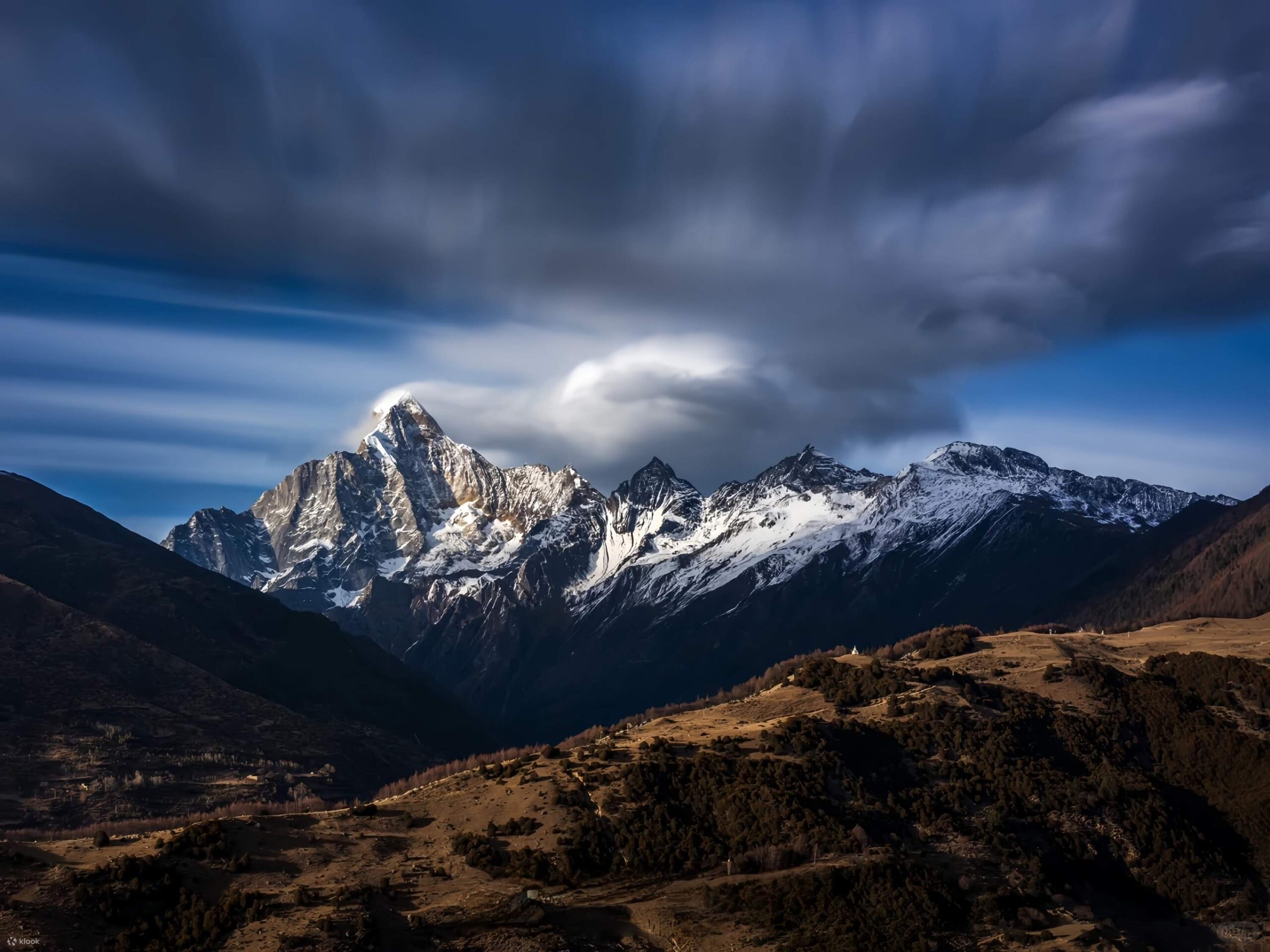
Siguniang Mountain.
Local Cuisine and Accommodation Nearby
When exploring the majestic landscapes of Mount Siguniang, an equally delightful culinary experience awaits you in the nearby towns. Siguniangshan Town, also known as Rilong, serves as the primary base for trekkers and adventurers alike, offering a unique blend of Tibetan and Sichuan cuisine.
Local Cuisine
Must-Try Dishes
-
Tibetan Yak Meat: Renowned for its rich flavor and tenderness, yak meat is a staple in Tibetan cuisine. Whether served as a hot pot or grilled, this dish is a must-try for meat lovers.
-
Momos: These Tibetan dumplings, often filled with yak meat or vegetables, are a popular snack among locals and visitors. They are steamed to perfection and served with a spicy dipping sauce.
-
Tibetan Butter Tea (Po Cha): A unique beverage made from tea, butter, and salt, this drink is both invigorating and warming—perfect for the cool mountain climate.
-
Sichuan Hot Pot: For those who crave a bit of spice, the local hot pots offer a fiery experience. Choose from a variety of fresh ingredients, including vegetables, meats, and local mushrooms, to cook in a bubbling broth right at your table.
-
Barley Wine (Chang): This traditional drink is made from fermented barley and is often consumed during meals or celebrations. Its slightly tangy flavor is a fantastic accompaniment to many dishes.
Dining Spots
-
Tibetan Family Restaurant: A cozy eatery where you can savor authentic Tibetan dishes, including yak meat and momos, served in a warm, welcoming atmosphere.
-
Siguniangshan Hotel Restaurant: Offering a mix of Tibetan and Chinese cuisine, this restaurant provides both hearty meals and stunning views of the mountains.
-
Local Street Vendors: For a quick bite, explore the street food scene. You’ll find vendors selling everything from grilled skewers to freshly made dumplings at affordable prices.
Accommodation Options
Where to Stay
-
Siguniangshan Hotel: This hotel features comfortable rooms with stunning mountain views. It provides amenities like a restaurant and tour assistance, making it a great choice for trekkers.
-
Tibetan Guesthouses: For a more immersive experience, consider staying in a traditional Tibetan guesthouse. These provide basic amenities and a chance to connect with local culture and hospitality.
-
Camping in the Valleys: For the adventurous, camping in one of the valleys such as Haizi Valley offers a unique experience. Many trekking operators provide guided camping tours that include meals and gear.
-
Hostels and Homestays: Budget travelers can find numerous hostels and homestays in Siguniangshan Town, offering both dormitory-style and private accommodations. These are excellent for meeting fellow travelers.
-
Boutique Hotels: If you prefer a touch of luxury, look for boutique hotels that blend modern comforts with traditional Tibetan decor, often featuring local art and textiles.
Conclusion
In and around Siguniang Mountain, delicious local cuisine and a variety of accommodation options cater to all tastes and budgets. Whether you’re enjoying a hearty Tibetan meal after a day of trekking or relaxing in a cozy guesthouse, the rich flavors and warm hospitality will enhance your adventure in this stunning landscape.
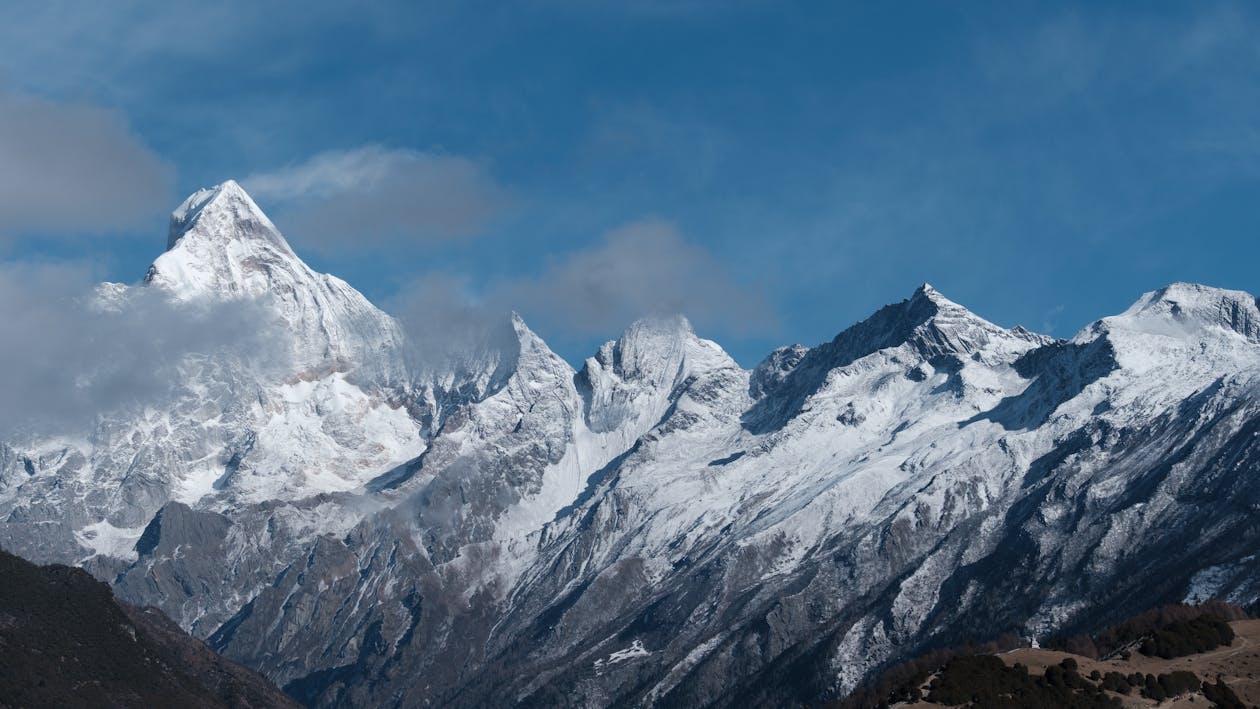
Siguniang Mountain.
Frequently Asked Questions
Frequently Asked Questions about Siguniang Mountain
-
How do I get to Siguniang Mountain from Chengdu?
To reach Siguniang Mountain, you can take a bus or hire a private car from Chengdu, which is approximately 220 km away. The drive takes about 4 hours, typically via Dujiangyan and Wolong. There are no direct trains or flights, so traveling to Chengdu first is essential. -
What is the best time to visit Siguniang Mountain?
The ideal time for trekking is from late September to November when the weather is clear, and the autumn colors are stunning. Late spring and summer (May to August) also offer beautiful landscapes, albeit with more rainfall. Avoid trekking in January to March when heavy snowfall can make higher areas inaccessible. -
What type of climate can I expect at Siguniang Mountain?
Siguniang Mountain has a plateau climate characterized by fresh air and significant temperature variations between day and night. Summers can be warm (around 12°C), while winters are cold (about -2°C). Be prepared for cool mornings and evenings even in summer. -
What trekking options are available?
Siguniang Mountain offers a range of trekking options for all levels, from easy day hikes in Shuangqiao Valley to more challenging multi-day treks that lead to higher peaks like Dafeng and Yaomeifeng. Popular valleys include Haizi Valley, Changping Valley, and Shuangqiao Valley. -
Are there guided tours available?
Yes, many local operators offer guided trekking tours, which can enhance your experience. These tours often include accommodations, meals, and transportation. It’s advisable to book in advance, especially during peak seasons. -
What should I pack for my trek?
Essential items include sturdy hiking boots, warm clothing (layers are best), a waterproof jacket, trekking poles, and adequate snacks and hydration. A good camera is also recommended for capturing the stunning landscapes! -
Is it possible to camp in the valleys?
Yes, camping is allowed in designated areas, particularly in Haizi Valley where there are established campsites. Make sure to follow local regulations and leave no trace to preserve the natural beauty of the area. -
Can I encounter wildlife while trekking?
Yes, Siguniang Mountain is home to diverse wildlife, including the famous giant panda. Trekking in the area provides opportunities to see various animals and unique flora, making it a paradise for nature enthusiasts and photographers alike.
Final Thoughts on Your Trip
As you prepare to leave the enchanting realm of Mount Siguniang, take a moment to reflect on the extraordinary adventure that awaits every traveler here. This majestic mountain range, often dubbed the “Eastward Alps,” offers a stunning tableau of nature’s artistry, where snow-capped peaks rise dramatically against the azure sky, and vibrant alpine meadows stretch as far as the eye can see.
Whether you wandered through the serene Shuangqiao Valley, marveled at the pristine lakes of Haizi Valley, or challenged yourself with the awe-inspiring climbs of the four towering peaks, each step in this outdoor paradise has likely left you with unforgettable memories. The rich tapestry of Tibetan culture that unfolds in the surrounding villages adds an enchanting layer to your journey, inviting you to connect with the local traditions and friendly smiles of the Qiang and Tibetan people.
As you pack away your trekking gear and prepare for the journey home, remember that the essence of Mount Siguniang extends beyond its breathtaking landscapes. It resides in the spirit of adventure that ignites your heart, the tranquil moments spent in nature, and the stories shared with fellow explorers.
Mount Siguniang is not merely a destination; it is a transformative experience that beckons you to return. So, whether you are already dreaming of your next trek or reflecting on the beauty you’ve witnessed, let the allure of this mountain continue to inspire your travels. Until we meet again on the trails, may your adventures be as boundless as the peaks of Siguniang.